[English] 日本語
 Yorodumi
Yorodumi- PDB-5sxy: The solution NMR structure for the PqqD truncation of Methylobact... -
+ Open data
Open data
- Basic information
Basic information
| Entry | Database: PDB / ID: 5sxy | |||||||||
|---|---|---|---|---|---|---|---|---|---|---|
| Title | The solution NMR structure for the PqqD truncation of Methylobacterium extorquens PqqCD representing a functional and stand-alone ribosomally synthesized and post-translational modified (RiPP) recognition element (RRE) | |||||||||
 Components Components | Bifunctional coenzyme PQQ synthesis protein C/D | |||||||||
 Keywords Keywords | CHAPERONE / RiPP RRE peptide scaffolding | |||||||||
| Function / homology |  Function and homology information Function and homology informationpyrroloquinoline-quinone synthase / pyrroloquinoline-quinone synthase activity / pyrroloquinoline quinone biosynthetic process / : / sulfur compound metabolic process / quinone binding Similarity search - Function | |||||||||
| Biological species |  Methylobacterium extorquens (bacteria) Methylobacterium extorquens (bacteria) | |||||||||
| Method | SOLUTION NMR / simulated annealing | |||||||||
 Authors Authors | Evans, R.L. / Xia, Y. / Wilmot, C.M. | |||||||||
| Funding support |  United States, 2items United States, 2items
| |||||||||
 Citation Citation |  Journal: Biochemistry / Year: 2017 Journal: Biochemistry / Year: 2017Title: Nuclear Magnetic Resonance Structure and Binding Studies of PqqD, a Chaperone Required in the Biosynthesis of the Bacterial Dehydrogenase Cofactor Pyrroloquinoline Quinone. Authors: Evans, R.L. / Latham, J.A. / Xia, Y. / Klinman, J.P. / Wilmot, C.M. #1:  Journal: to be published Journal: to be publishedTitle: 1H, 13C, and 15N resonance assignments and secondary structure information for Methylobacterium extorquens PqqD and the complex of PqqD with PqqA Authors: Evans, R.L. / Latham, J.A. / Klinman, J.P. / Wilmot, C.M. / Xia, Y. | |||||||||
| History |
|
- Structure visualization
Structure visualization
| Structure viewer | Molecule:  Molmil Molmil Jmol/JSmol Jmol/JSmol |
|---|
- Downloads & links
Downloads & links
- Download
Download
| PDBx/mmCIF format |  5sxy.cif.gz 5sxy.cif.gz | 571.6 KB | Display |  PDBx/mmCIF format PDBx/mmCIF format |
|---|---|---|---|---|
| PDB format |  pdb5sxy.ent.gz pdb5sxy.ent.gz | 479.7 KB | Display |  PDB format PDB format |
| PDBx/mmJSON format |  5sxy.json.gz 5sxy.json.gz | Tree view |  PDBx/mmJSON format PDBx/mmJSON format | |
| Others |  Other downloads Other downloads |
-Validation report
| Summary document |  5sxy_validation.pdf.gz 5sxy_validation.pdf.gz | 401.9 KB | Display |  wwPDB validaton report wwPDB validaton report |
|---|---|---|---|---|
| Full document |  5sxy_full_validation.pdf.gz 5sxy_full_validation.pdf.gz | 515.7 KB | Display | |
| Data in XML |  5sxy_validation.xml.gz 5sxy_validation.xml.gz | 28.8 KB | Display | |
| Data in CIF |  5sxy_validation.cif.gz 5sxy_validation.cif.gz | 48.6 KB | Display | |
| Arichive directory |  https://data.pdbj.org/pub/pdb/validation_reports/sx/5sxy https://data.pdbj.org/pub/pdb/validation_reports/sx/5sxy ftp://data.pdbj.org/pub/pdb/validation_reports/sx/5sxy ftp://data.pdbj.org/pub/pdb/validation_reports/sx/5sxy | HTTPS FTP |
-Related structure data
| Similar structure data | |
|---|---|
| Other databases |
|
- Links
Links
- Assembly
Assembly
| Deposited unit | 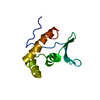
| |||||||||
|---|---|---|---|---|---|---|---|---|---|---|
| 1 |
| |||||||||
| NMR ensembles |
|
- Components
Components
| #1: Protein | Mass: 10421.945 Da / Num. of mol.: 1 Source method: isolated from a genetically manipulated source Source: (gene. exp.)  Methylobacterium extorquens (strain ATCC 14718 / DSM 1338 / AM1) (bacteria) Methylobacterium extorquens (strain ATCC 14718 / DSM 1338 / AM1) (bacteria)Strain: ATCC 14718 / DSM 1338 / AM1 / Gene: pqqCD, MexAM1_META1p1749 / Plasmid: pET28a / Production host:  References: UniProt: Q49150, pyrroloquinoline-quinone synthase |
|---|
-Experimental details
-Experiment
| Experiment | Method: SOLUTION NMR | ||||||||||||||||||||||||||||||||||||||||||||||||||||||||||||||||||||||||||||||||||||||||||||||||||||||
|---|---|---|---|---|---|---|---|---|---|---|---|---|---|---|---|---|---|---|---|---|---|---|---|---|---|---|---|---|---|---|---|---|---|---|---|---|---|---|---|---|---|---|---|---|---|---|---|---|---|---|---|---|---|---|---|---|---|---|---|---|---|---|---|---|---|---|---|---|---|---|---|---|---|---|---|---|---|---|---|---|---|---|---|---|---|---|---|---|---|---|---|---|---|---|---|---|---|---|---|---|---|---|---|
| NMR experiment |
|
- Sample preparation
Sample preparation
| Details | Type: solution / Contents: 4.6 mg/mL [U-13C; U-15N] PqqD, 95% H2O/5% D2O Details: PqqD sample contained 285 micro-L of 5.0 mg/ml (0.40 mM) 13C-, 15N-labeled M.ex.PqqD in 25 mM potassium phosphate, pH 6.5, 7 micro-L of 50 mM sodium azide, and 15 micro-L HPLC grade D2O. ...Details: PqqD sample contained 285 micro-L of 5.0 mg/ml (0.40 mM) 13C-, 15N-labeled M.ex.PqqD in 25 mM potassium phosphate, pH 6.5, 7 micro-L of 50 mM sodium azide, and 15 micro-L HPLC grade D2O. Final concentrations: 4.6 mg/ml (0.37 mM) MexPqqD, 1.1 mM sodium azide, 4.9% D2O). Label: PqqD / Solvent system: 95% H2O/5% D2O |
|---|---|
| Sample | Conc.: 4.6 mg/mL / Component: PqqD / Isotopic labeling: [U-13C; U-15N] |
| Sample conditions | Details: PqqD sample contained 285 micro-L of 5.0 mg/ml (0.40 mM) 13C-, 15N-labeled M.ex.PqqD in 25 mM potassium phosphate, pH 6.5, 7 micro-L of 50 mM sodium azide, and 15 micro-L HPLC grade D2O. ...Details: PqqD sample contained 285 micro-L of 5.0 mg/ml (0.40 mM) 13C-, 15N-labeled M.ex.PqqD in 25 mM potassium phosphate, pH 6.5, 7 micro-L of 50 mM sodium azide, and 15 micro-L HPLC grade D2O. Final concentrations: 4.6 mg/ml (0.37 mM) MexPqqD, 1.1 mM sodium azide, 4.9% D2O). Ionic strength: 25 mM / Label: PqqD / pH: 6.5 / Pressure: 1 atm / Temperature: 298 K |
-NMR measurement
| NMR spectrometer |
|
|---|
- Processing
Processing
| NMR software |
| ||||||||||||||||||||||||
|---|---|---|---|---|---|---|---|---|---|---|---|---|---|---|---|---|---|---|---|---|---|---|---|---|---|
| Refinement | Method: simulated annealing / Software ordinal: 6 | ||||||||||||||||||||||||
| NMR representative | Selection criteria: lowest energy | ||||||||||||||||||||||||
| NMR ensemble | Conformer selection criteria: structures with the lowest energy Conformers calculated total number: 100 / Conformers submitted total number: 20 |
 Movie
Movie Controller
Controller


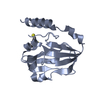

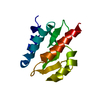
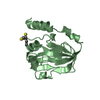
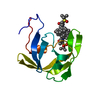
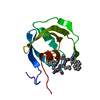
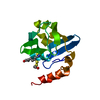

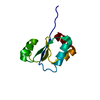
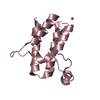
 PDBj
PDBj
 HSQC
HSQC